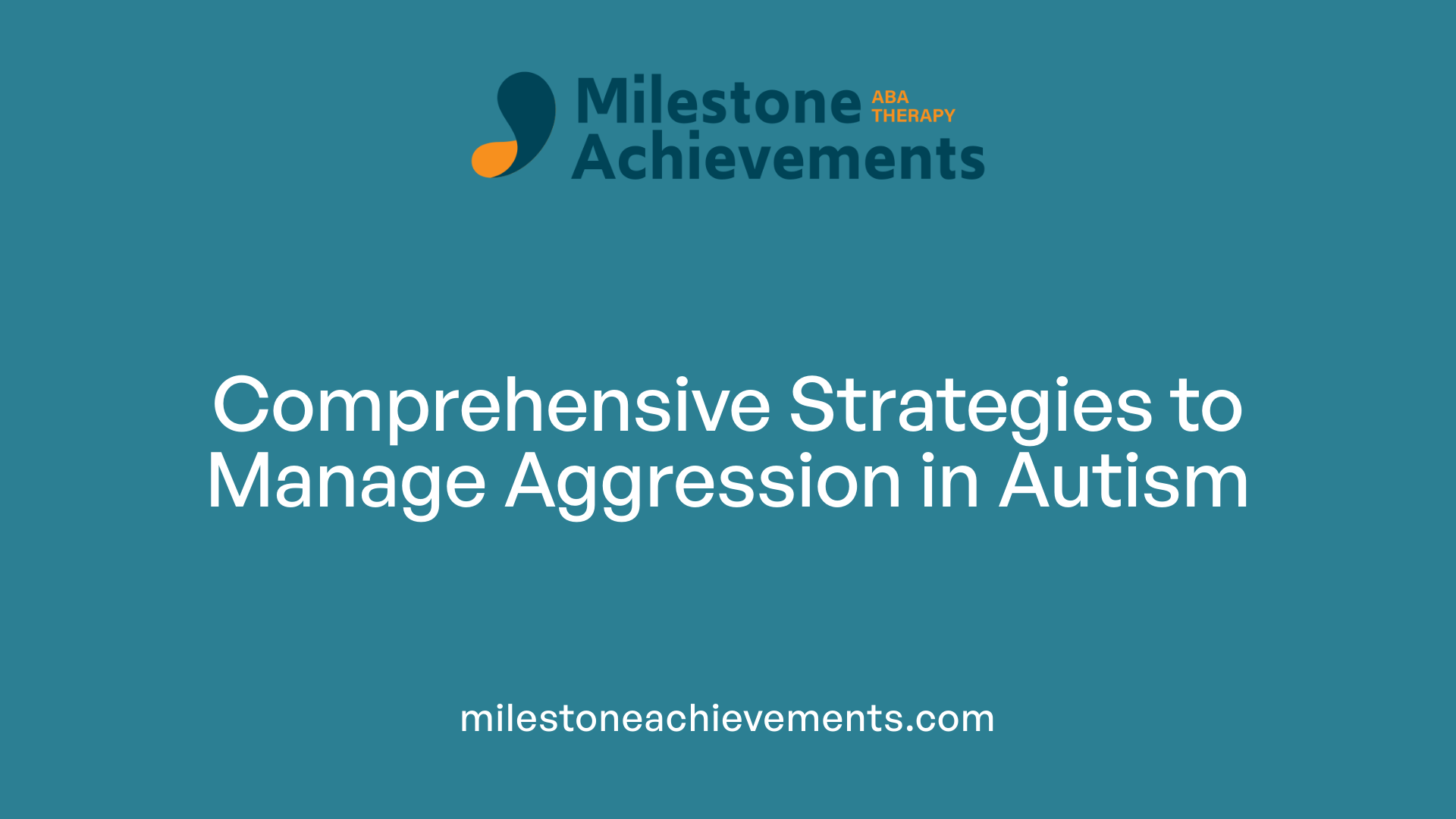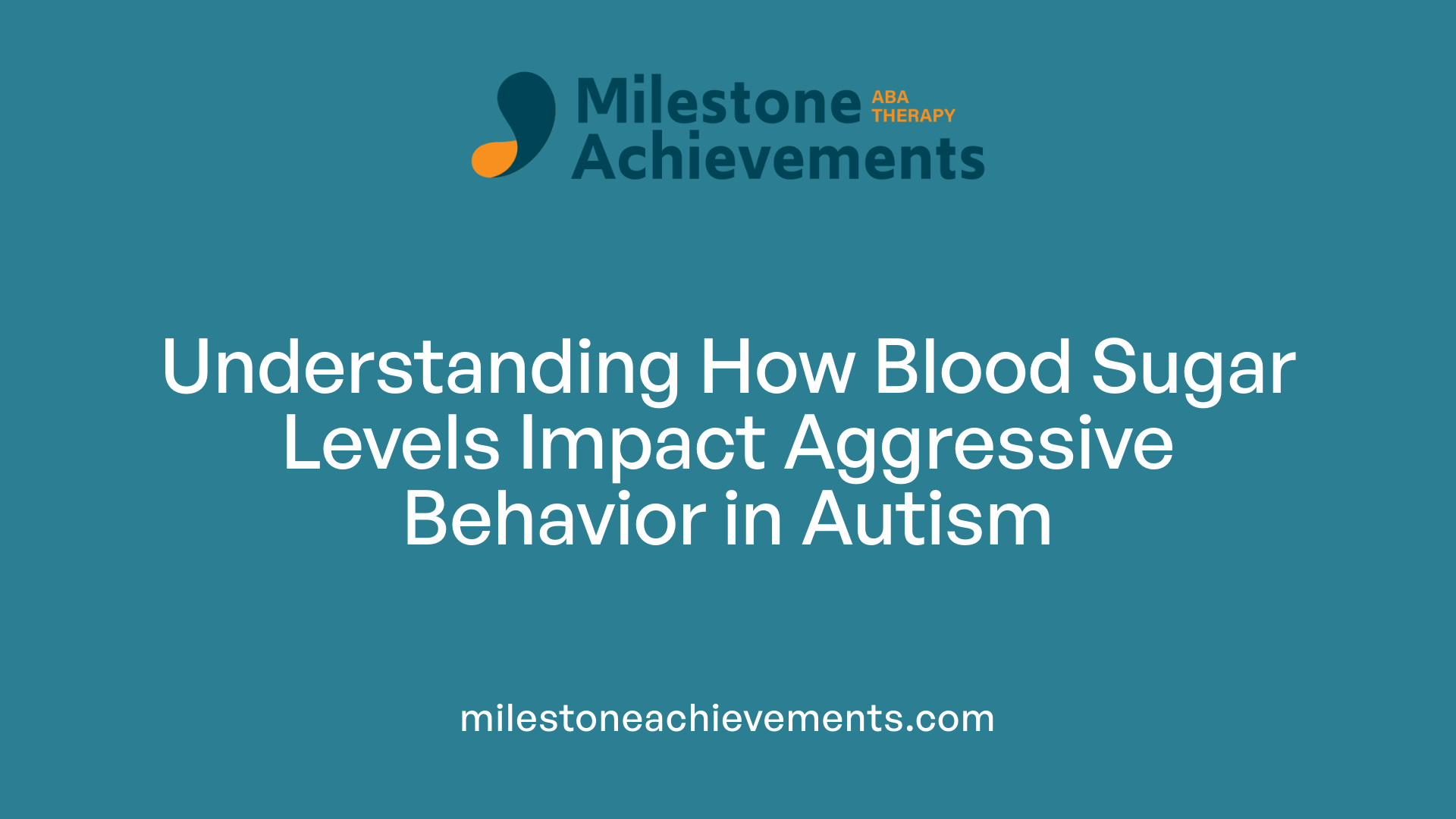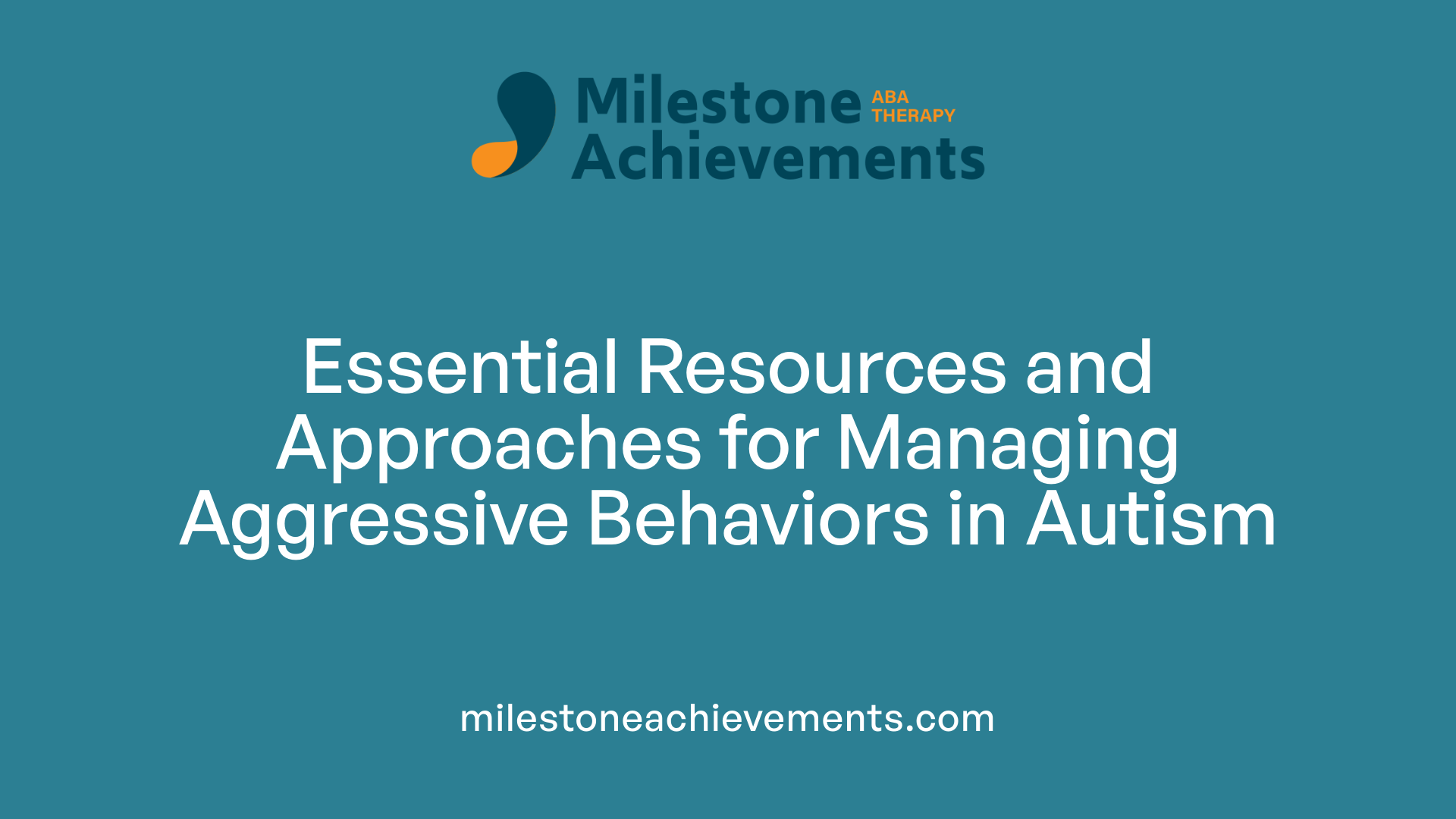Autism Violent Behaviors
Understanding and Addressing Challenging Behaviors in Autism

A Comprehensive Overview of Autism, Aggression, and Management Strategies
Autism Spectrum Disorder (ASD) is often associated with a variety of behavioral challenges, among which aggressive behaviors are particularly concerning for families, caregivers, and professionals. This article explores the nature of aggressive behaviors in autism, their underlying causes, and effective approaches for management and intervention. Emphasizing a holistic, multidisciplinary perspective, we will analyze biological, psychological, and environmental factors, highlight current treatment options, and provide practical resources to support individuals and their support networks.
Defining Aggression in Autism and Its Manifestations
What is aggression in autism?
Aggression in autism encompasses a range of intense behaviors that can be physical, verbal, or behavioral. It often appears as severe tantrums, anger, hostility, or violent outbursts that may include hitting, biting, scratching, and self-injury. These behaviors are not merely acts of anger but often serve as a form of communication for individuals who have difficulty expressing their needs and feelings.
Physical actions such as hitting, biting, scratching, pinching, hair pulling, slapping, punching, and kicking are common signs of aggression. Self-injurious activities like head banging or head slapping are also prevalent and can be deeply distressing for caregivers.
Verbal expressions of aggression include shouting, threatening, or using offensive language. These outbursts may be responses to frustration, sensory overload, or inability to communicate effectively.
Unusual behaviors such as body rocking, hand-flapping, rapid speech, and holding atypical body positions can sometimes be linked to sensory sensitivities or emotional distress. These actions may also be part of intense energy or sensory-seeking behaviors.
Understanding the diverse manifestations of aggression is vital for implementing effective intervention strategies that can improve quality of life and safety for individuals with autism.
For more details on symptoms and characteristics, search terms like "Signs and characteristics of aggressive behaviors in autism" can provide extensive insights.
Understanding the Causes of Aggression in Autism
What causes aggression in people with autism?
Aggression in individuals with autism often stems from multiple interconnected factors. One primary cause is communication frustrations; when children or adults struggle to express their needs or discomfort, they may resort to physical actions like hitting or biting as a way to communicate distress.
Sensory sensitivities also play a significant role. Many autistic individuals are overwhelmed by strong smells, loud noises, bright lights, or other intense sensory inputs. When they are unable to process or cope with these sensations effectively, aggressive behaviors can emerge as a response.
Underlying medical issues can further contribute to aggression. Sleep disturbances, such as insomnia, gastrointestinal problems, or untreated mental health conditions like anxiety or depression can increase irritability and reduce tolerance for stress.
Emotional challenges like difficulty regulating feelings, irritability, or anxiety, especially during times of change or routine disruptions, often lead to aggressive outbursts. These behaviors serve as non-verbal signals of their internal state.
Environmental triggers are also influential. Loud environments, strong smells, or chaotic settings may overwhelm their senses, prompting aggression. Managing these triggers through environmental adjustments can help mitigate such responses.
On the neurobiological level, imbalances in neurotransmitters and hormonal influences may predispose autistic individuals to behavioral difficulties, including aggression. Ongoing research aims to better understand these biological components to develop targeted interventions.
Effectively addressing aggression involves identifying and reducing these triggers. Strategies include behavioral therapies, environmental modifications, medical treatments for underlying issues, and fostering improved communication skills. Such a comprehensive approach can enhance quality of life for autistic individuals and reduce episodes of aggression.
Management and Treatment Strategies for Aggressive Behaviors
 Autism-related aggression can be addressed through various strategies that focus on understanding and modifying behaviors. Behavioral interventions are central to these efforts. For instance, Functional Behavioral Assessment (FBA) helps professionals identify the exact triggers and purposes behind aggressive actions. Based on these insights, Applied Behavior Analysis (ABA) employs reinforcement and teaching techniques like functional communication training (FCT) to help individuals express their needs appropriately, reducing frustration and aggression.
Autism-related aggression can be addressed through various strategies that focus on understanding and modifying behaviors. Behavioral interventions are central to these efforts. For instance, Functional Behavioral Assessment (FBA) helps professionals identify the exact triggers and purposes behind aggressive actions. Based on these insights, Applied Behavior Analysis (ABA) employs reinforcement and teaching techniques like functional communication training (FCT) to help individuals express their needs appropriately, reducing frustration and aggression.
Medications also play a role in managing severe or persistent aggressive behaviors. The FDA has approved antipsychotic medications such as risperidone and aripiprazole, which have demonstrated effectiveness in reducing irritability and aggression in children with autism. When combined with behavioral therapies, these medications often yield better results.
Creating a supportive environment is equally important. This includes environmental modifications, sensory supports like calming activities or sensory rooms, and structured routines to promote predictability and reduce anxiety. Providing physical activity and sensory input, such as trampoline jumping or squeezable toys, can help regulate energy and emotions.
Effective management requires a team approach. Multidisciplinary collaborations involving healthcare providers, psychologists, behavior specialists, and caregivers ensure that customized plans address the unique needs of each individual. This comprehensive approach, integrating behavioral, medical, and environmental strategies, offers the best chance for reducing aggression and enhancing quality of life for those with autism.
Blood Glucose and Its Connection to Aggression in Autism

How does blood glucose level relate to aggression in autistic individuals?
Blood sugar fluctuations can significantly influence mood and behavior, especially in individuals with autism. Variations between high and low blood glucose levels often trigger irritability and aggressive outbursts.
Research indicates that prenatal exposure to high blood sugar levels, such as hyperglycemia, can disrupt normal brain development. These metabolic disturbances may impair neuronal migration and connectivity, potentially contributing to autism spectrum disorder (ASD) and its associated behaviors, including irritability and aggression.
In neonates and children, both hypoglycemia (low blood sugar) and hyperglycemia (high blood sugar) can cause harm to brain development and neural functioning. These imbalances increase the risk of behavioral challenges, including aggressive episodes.
Many autistic individuals experience difficulty regulating their blood glucose levels. When they feel hungry or experience blood sugar imbalances, it can directly provoke aggressive responses. Managing blood glucose through a balanced diet, nutritional support, and addressing underlying metabolic health issues can help mitigate these behavioral problems.
In conclusion, stabilizing blood sugar levels may offer a helpful approach to reducing aggression and enhancing overall behavior in people with autism, highlighting the importance of metabolic health in behavioral management.
Strategies to Help Children and Teenagers Manage Aggression
Managing aggression in children and teenagers with autism involves multiple strategies tailored to individual needs. Establishing predictable routines helps reduce uncertainty and instability, which can trigger aggressive behaviors. Visual supports such as schedules, social stories, and communication boards serve as effective tools to prepare individuals for routine changes and let them understand expectations.
Creating safe spaces where children can retreat during distressing moments allows them to self-regulate and calm down without causing harm to themselves or others. During outbursts, caregivers should respond calmly, using short, clear phrases or visual cues to facilitate communication and de-escalation. These methods help prevent escalation and promote understanding.
Behavioral techniques like Applied Behavior Analysis (ABA) and Functional Communication Training (FCT) are scientifically supported methods that identify the functions behind behaviors. ABA involves assessing the antecedents and consequences of aggression and developing reinforcement strategies to encourage more appropriate responses. FCT teaches alternative ways for children to express their needs, reducing frustration and aggressive acts.
Environmental modifications, such as reducing sensory overload through dim lighting, noise reduction, or calming tactile activities, can prevent triggers. Anticipatory communication about upcoming changes using visual supports can decrease anxiety related to routine disruptions.
Collaboration among parents, educators, therapists, and healthcare providers forms the foundation of effective management. Sometimes, medications prescribed by healthcare professionals complement behavioral interventions, especially when aggression is severe. However, a balanced approach involving consistent, compassionate strategies and professional guidance offers the best support for children and teenagers with autism.
Effective Responses and Support Techniques During Aggressive Episodes
When managing aggressive behaviors in autistic children, the first priority is ensuring safety by remaining calm and removing any objects that could cause harm. Creating a secure environment helps prevent injury and reduces the child's distress.
Utilizing visual supports, such as social stories and visual cues, can clarify expectations and help the child understand routines, reducing frustration and confusion. Consistent routines and calming strategies, like scheduled sensory breaks or relaxation activities, are essential tools.
Addressing triggers like sensory overload or physical discomfort can significantly decrease aggressive episodes. This might involve environmental adjustments, such as dimming lights or reducing noise, and providing sensory tools like squeeze toys or weighted blankets. Recognizing signs of stress early enables caregivers to intervene with calming strategies.
Professional guidance is crucial, especially if behaviors escalate or pose safety risks. Physical restraint should only be performed by trained professionals, as improper use can increase anxiety or injury. Post-episode, reassurance and gentle reconnection help the child regain composure.
Developing an individualized behavior plan is highly effective. Such plans, created with input from behavior specialists and caregivers, focus on positive reinforcement, skill development, and teaching alternative, appropriate ways to communicate needs and feelings. This holistic approach supports reducing aggression and promoting healthier interactions.
Harnessing Resources for Better Understanding and Management

What resources are available to help understand and manage aggression in autism?
Understanding and managing aggressive behaviors in children with autism involves a multifaceted approach supported by various resources. Educational materials and community resources provide valuable information for families and caregivers. For instance, the Autism Resource Center offers guidance on recognizing early signs of aggression, exploring treatment options, and understanding clinical practices.
Behavioral interventions form the cornerstone of effective management. Applied Behavior Analysis (ABA), Functional Behavioral Assessment (FBA), and Functional Communication Training (FCT) are evidence-based strategies. These approaches help identify the purpose behind aggressive acts—such as communication needs or sensory overload—and teach alternative behaviors. Therapies often involve reinforcement of positive behaviors and developing communication skills to reduce frustration.
Medical evaluation is crucial to rule out underlying health issues that may trigger aggression. Pain from dental problems, gastrointestinal discomfort, or sleep problems like insomnia can heighten irritability. Proper diagnosis and treatment of these conditions can lead to a significant reduction in aggressive episodes.
Creating supportive environments is also essential. Using visual supports like social stories, scheduled routines, and calming techniques helps prevent triggers. Structured settings facilitate better emotional regulation and provide predictability, easing anxiety and frustration.
In some cases, medications such as risperidone and aripiprazole are prescribed to manage irritability and aggressive behaviors. These are typically used alongside behavioral therapies under the supervision of a healthcare professional.
Overall, a blend of educational resources, behavioral interventions, medical support, and environmental modifications creates a comprehensive framework for managing aggression in autism effectively. Collaboration between families, clinicians, and educators ensures a tailored approach that addresses individual needs and promotes positive behavior.
A Holistic Approach to Managing and Supporting Autism-Related Violence
Addressing aggressive behaviors in autism requires a compassionate, evidence-based approach that combines understanding of underlying causes with tailored interventions. Medical, behavioral, and environmental strategies should be integrated to provide comprehensive support. Collaboration among caregivers, professionals, and support networks is essential to optimize outcomes and improve quality of life for individuals on the spectrum. Ongoing research and resource development continue to enhance our capacity to manage these challenging behaviors effectively, emphasizing patience, education, and individualized care.
References
- Understanding Aggressive Behavior in Autism
- Autism aggression: What can help?
- Distressed behaviour - a guide for all audiences
- An Overview of Aggressive Behaviors in Children with Autism ...
- Aggression in autism spectrum disorder: presentation and treatment ...
- Aggressive Behaviors and Verbal Communication Skills in Autism ...
- Aggressive behaviour: autistic children and teenagers
- Violence and autism - Wikipedia
- Managing Aggressive Behavior in Adolescents With Autism ...
- Violent behavior in autism spectrum disorders: Who's at risk?







